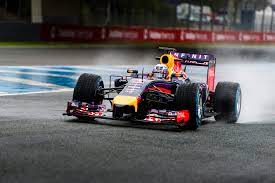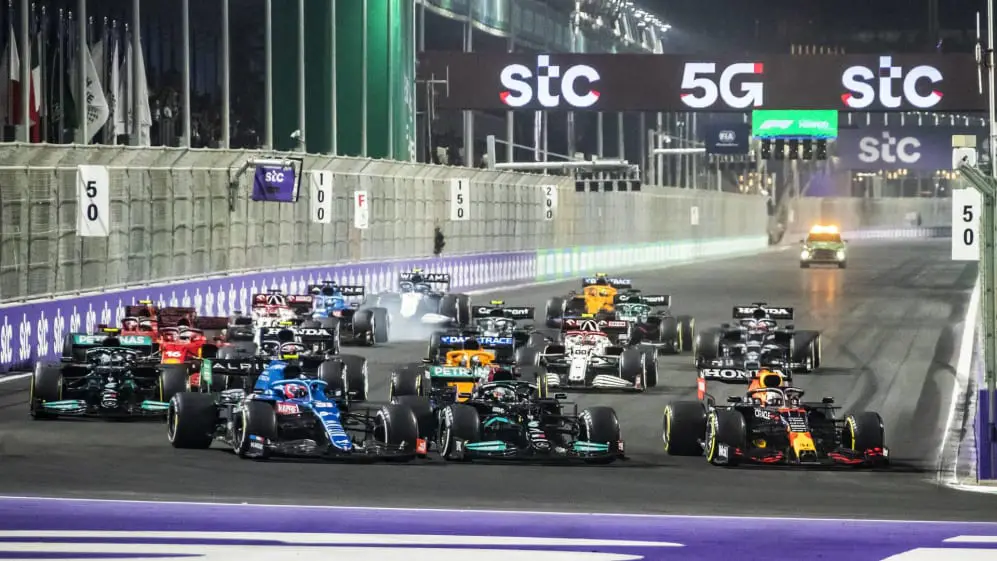Are you fascinated by the speed and thrill of an F1 car? Do you wonder how these machines can achieve such incredible performance and precision? Do you want to learn more about the facts and figures behind the fastest cars in the world?
F1 cars have been recorded at speeds of 397.36 km/h (246.9 mph), when run over the he Bonneville Salt Flats in the US. Valtteri Bottas holds the record for the fastest speed recorded during an F1 race of 372.5 km/h (231.4 mph) while he participated in the 2016 Mexican Grand Prix.
By the end of this article, you will have a better understanding of the amazing capabilities of these cars. You will also discover some surprising and intriguing facts that will make you appreciate F1 even more.
So buckle up and get ready for a ride that will leave you breathless. This is how fast an F1 car is.
How Fast Does An F1 Car Accelerate

One of the most impressive aspects of an F1 car is its acceleration. F1 cars can go from 0 to 60 mph in about 2.6 seconds, which is faster than most sports cars. However, this is not the fastest acceleration in motorsport. Other categories of race cars, such as dragsters, rally cars and MotoGP bikes, can achieve similar or better times.
Where an F1 car comes into its own is its acceleration from 100 to 200 km/h (62 to 124 mph). They achieve this in about 1.9 seconds. It means that an F1 car can go from 0 to 200 km/h (124 mph) in about 4.5 seconds. This is faster than almost any other car on the planet.
The reason why F1 cars can accelerate so quickly is because of their power-to-weight ratio. This is the amount of power they have relative to their weight. F1 cars have a power-to-weight ratio of about 1.6 kW/kg (2.2 hp/lb). It is much higher than most road cars, which have a power-to-weight ratio of about 0.08 kW/kg (0.11 hp/lb).
Another factor that contributes to the acceleration of F1 cars is their aerodynamics, which provide them with downforce.
Downforce is the force that pushes the car down onto the track, increasing its grip and stability. F1 cars have sophisticated wings and bodywork that generate downforce at high speeds. This allows them to corner faster and brake later.
What Is The Top Speed Recorded By An F1 Car?

The top speed of an F1 car depends on several factors, such as the engine power, the aerodynamic drag, the gear ratios, the fuel load and the track layout.
Different tracks have different characteristics. These can include long straights or tight corners, that affect the top speed of an F1 car.
Kevin Magnussen holds the fastest speed record in an F1 qualifying session in 2022 was 351.7 km/h (218.5 mph). ,
Valtteri Bottas currently holds the record for the highest speed in an F1 race. He achieved 372.5 km/h (231.4 mph) in the 2016 Mexican Grand Prix.
However, these are not the fastest speeds ever achieved by an F1 car. The fastest speed set with an F1 car is 397.36 km/h (246.9 mph). This was set by Honda in 2005 at the Bonneville Salt Flats in the US.
Honda used their RA106 race car, which had been modified in several ways. This helped it achieve the remarkable speed. It also used special tires and had its rear wing removed to decrease drag.
Which Is Faster A 2023 F1 Car Or A MotoGP Bike?

A MotoGP bike is a motorcycle that competes in the premier class of motorcycle racing. It is is considered to be the equivalent of Formula 1 for bikes. MotoGP bikes are very fast and agile machines. They are capable of reaching speeds of over 350 km/h (217 mph) on some tracks.
However, MotoGP bikes are not faster than F1 cars overall. MotoGP bikes have a slight advantage in acceleration and top speed on some tracks. They are, however, much slower than F1 cars in terms of cornering speed and braking performance.
This is because MotoGP bikes have much less downforce and grip than F1 cars. It limits their ability to take corners at high speeds and decelerate quickly. MotoGP bikes also have less stability and control than F1 cars, which makes them more prone to sliding and crashing.
Some Real Life Examples
The following examples compare the lap times of F1 cars and MotoGP bikes on the same track.
- At Silverstone in 2022, Lewis Hamilton set the fastest lap in an F1 race with a time of 1:27.369. Marc Marquez set the fastest lap in a MotoGP race with a time of 1:59.936. This means that Hamilton was 32.567 seconds faster than Marquez, or about 27% faster.
- At Catalunya (Spain) in 2022, Max Verstappen set the fastest lap in an F1 race with a time of 1:18.149. Fabio Quartararo set the fastest lap in a MotoGP race with a time of 1:40.707. This means that Verstappen was 22.558 seconds faster than Quartararo, or about 22% faster.
- At Spielberg (Austria) in 2022, Lewis Hamilton set the fastest lap in an F1 race with a time of 1:07.712. Andrea Dovizioso set the fastest lap in a MotoGP race with a time of 1:23.827. This means that Hamilton was 16.115 seconds faster than Dovizioso, or about 19% faster.
As we can see, F1 cars are significantly faster than MotoGP bikes on every track. The average difference is about 23%.
Does A Tesla Model S Accelerate Faster Than An F1 Car
A Tesla Model S is an electric car that is known for its impressive acceleration and performance. The Model S, the Plaid, claims to be able to go from 0 to 60 mph in 1.99 seconds. It makes it the fastest production car available.
However, this does not mean that the Tesla Model S accelerates faster than an F1 car. There are several reasons why this comparison is not fair or accurate:
The Tesla Starts With A 1 Foot Rollout
Tesla uses a different measurement method than F1 cars.
The Tesla Model S measures its 0-60 mph time using a one-foot rollout. This means that the timer starts after the car has already moved one foot from the starting line.
This gives the car a slight advantage over cars that measure their 0-60 mph time from a standstill.
The Tesla Has Torque From Its Electric Motor

The Tesla Model S benefits from its electric drivetrain, which provides instant torque and power delivery without any lag or shifting gears. This gives the car an edge over combustion-engine cars, especially at low speeds and from a standstill.
However, this advantage diminishes as the speed increases, as electric motors have less power at higher RPMs than combustion engines.
The Tesla Is Heavier And Has Traction Control
Tesla’s Model S is much heavier than an F1 car, which affects its acceleration and performance.
- The Tesla Model S weighs about 2,162 kg (4,766 lb),
- An F1 car weighs about 752 kg (1,658 lb) (including driver and fuel).
The Tesla Model S has a power-to-weight ratio of about 0.5 kW/kg (0.7 hp/lb). An F1 car has a power-to-weight ratio of about 1.6 kW/kg (2.2 hp/lb).
The result is that an F1 car has more power relative to its weight. It allows it to accelerate faster once moving and reach higher speeds.
The Tesla Model S can beat an F1 car in a very short sprint from 0 to 60 mph. It can’t keep up with an F1 car in terms of acceleration and speed beyond that point.
Conclusion
Formula 1 cars are among the fastest and most advanced vehicles in the world. They are capable of reaching speeds of over 350 km/h (217 mph). They accelerate from 0 to 200 km/h (124 mph) in about 4.5 seconds.
However, F1 cars are not just about speed; they are also about precision, efficiency and innovation. F1 cars use sophisticated technology and engineering to optimize their performance and reliability, as well as to comply with strict regulations and safety standards.
They are constantly evolving and improving, as teams and manufacturers strive to gain an edge over their rivals and win races and championships. F1 cars are the ultimate expression of motorsport excellence and passion.
If you enjoyed reading this article there are many more like it at www.f1worldwide.com. Other articles that may be of interest include the following.
- How Much Power Do F1 Engines Produce?
- The Ultimate Guide To How Much Formula 1 Cars Really Weigh
- The Anatomy Of A Formula One Car
- Inside The F1 Steering Wheel: The Ultimate Control Panel For Racecar Drivers
- How DRS Can Make A Formula 1 Car Win: The Ultimate Guide to the Drag Reduction System (DRS F1)

